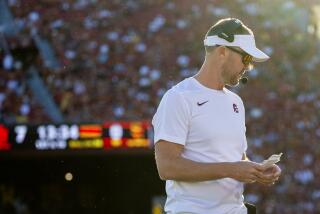After Win No. 300, Ryan Shows Time Is Still on His Side
- Share via
MILWAUKEE — Time--someone in a hurry no doubt first said--waits for no man. But it still loiters shamelessly wherever Nolan Ryan plants his spikes.
Older men have won baseball games, and younger men have won more of them. But at an age when, like the former, he should be relying mostly on guile, he is, like the latter, still relying on the gift. The thrill, inexplicably, is not gone.
Because while time has diminished everything from the number of hairs on the top of his head to the suppleness at the tips of his toes, it has taken nothing away from his fastball. And so the barriers that everyone else must respect continue to be smashed by 43-year-old Lynn Nolan Ryan Jr.
Tuesday night in County Stadium, it was major league win No. 300. But little more than a month earlier, it was no-hitter No. 6. And only last August it was strikeout victim No. 5,000.
The numbers provide a measure of how often and how long, but not how. That remains the great mystery.
“The way his fastball was cutting away, it was hard to get a bead on,” said Milwaukee’s Paul Molitor, who struck out twice Tuesday against Ryan, limiting his career total in that department to a respectable eight.
“I had some good cuts up there, but I couldn’t figure out where the ball was moving. He had more movement on the fastball,” Molitor said, “than he’s had in the past.”
Bob Feller, another great fastballer, set a single-season strikeout mark of 348 in 1946, slipped on a mound in Philadelphia the following season and never had that blurring, exhilarating, most magical of pitches at his command again.
“All of a sudden,” Feller recalled in an interview last year, “you’re wondering how to pitch to hitters whose names you never had to know because you could always blow the ball by them.
“But that hasn’t happened to Ryan yet. It will someday, but who knows when?”
The answer is, not any time soon.
Tuesday night, the Ryan Express rolled into the eighth inning with a 5-1 lead and 121 pitches already credited against his account. He gave up a single to leadoff man Molitor, ran into more trouble when second baseman Julio Franco misplayed Robin Yount’s potential double-play grounder, and appeared ready for a trip back to the clubhouse when Gary Sheffield, one of the American League’s hottest hitters, arrived at the plate next.
Instead, Ryan reared back under a full head of steam, testing the radar gun and terrifying Sheffield with fastball after fastball, Finally, the youngster--who was not born until a few months after Ryan had completed his first full major league season, with the New York Mets in 1968--gave way and popped out weakly to short.
“I came up in the eighth,” Sheffield said afterward, almost defensively, “and he’s still throwing in the 90s. I guess that shows he’s in good shape.”
Conditioning, concentration, commitment, desire, mechanics--each quality, stretched to its limit--together seem a plausible explanation for Ryan’s longevity. But somehow, Ryan is more than the sum of them. He has gotten older, to be sure, but he seems to have gotten better as well.
In his 20s and 30s, Ryan’s ratio of strikeouts to walks hovered around 2-to-1. In his 40s, it is nudging closer to 3-to-1. He has spent his career with four teams whose winning percentage has been only a few steps above .500, and his own has been only half a step better than theirs.
Yet, when the clock struck midnight, he was 11-4 on the year and seemed genuinely surprised the carriage sent to carry him into pitching’s elite circle had not turned into a pumpkin.
“I’ve said this before,” Ryan said, “but when I started out, the only goal I had was to play four years and lock up a pension, and there were times when that was in doubt.”
In the end, though, the most remarkable thing about Ryan may not be how long he possessed the gift of throwing fast, but that he used it at all. Self-effacing to a fault, Ryan, like Gary Cooper in “High Noon,” came to duel only reluctantly and liked talking about it even less.
He was late in accepting the game as his livelihood and still has trouble dealing with celebrity. He combatted the ever-widening publicity surrounding his feats of late by signing more autographs than ever before, if only to keep the dealers from turning an unhealthy profit.
He had no idea what the worth of his rookie baseball card had rocketed to--$3,900 at a recent Florida auction--and when asked how he planned to celebrate this milestone, Ryan replied:
“I don’t have any plans. I’m probably one of the most boring people around. Actually, I’ll probably celebrate when things get back to normal. It will be nice to go out and pitch without all the anxiety that’s been attached to things the last couple of weeks.”
In that sense, Ryan already is a victim of his own success. He is already breathing such rarefied air that, if retirement doesn’t claim him soon, another plateau will be there for the scaling. And another and another and another.
“I’m sure people will find this hard to believe,” Ryan responded when asked what was next, “but I’m not a numbers-oriented person and I don’t set goals in terms of numbers.”
Of course. Nolan Ryan doesn’t have to.
Time, for some mystical reason at which the rest of us can only guess, is already on his side.
More to Read
Go beyond the scoreboard
Get the latest on L.A.'s teams in the daily Sports Report newsletter.
You may occasionally receive promotional content from the Los Angeles Times.










